Please cite as : Nong WY, Chai ZY, Jiang X, Qin J, Ma KY, Chan KM, Chan TF, Chow BK, Kwan HS, Wong CK, Qiu JW, Hui JHL*, Chu KH. (2020). A crustacean annotated transcriptome (CAT) database. BMC genomics. Dec;21(1):1-5. DOI https://doi.org/10.1186/s12864-019-6433-3
Introduction : Crustaceans represent a large and important group in the animal Kingdom. Of particular importance is the class of malocostracans, where annual human consumption exceeds 10 million tons. These animals also significantly influence the ecology in all marine environments as well as most freshwater streams. The Order Decapoda is of the greatest interest to industry with the most common food animals in crabs and shrimp. The current database collates major representative species from the decapods with a stomatopod model species as an outgroup within the same Class.
Research in this important Class has seen the increasing frequency of publications generating transcriptomic data for diverse member species, especially with de novo sequencing exercises. Most common post-assembly analyses rely on annotation from a closely related model species. The transcriptome database for each model species here provides an invaluable tool for assisting the analysis of transcriptomic data from any members of the Malocostraca.
Introduction : Crustaceans represent a large and important group in the animal Kingdom. Of particular importance is the class of malocostracans, where annual human consumption exceeds 10 million tons. These animals also significantly influence the ecology in all marine environments as well as most freshwater streams. The Order Decapoda is of the greatest interest to industry with the most common food animals in crabs and shrimp. The current database collates major representative species from the decapods with a stomatopod model species as an outgroup within the same Class.
Research in this important Class has seen the increasing frequency of publications generating transcriptomic data for diverse member species, especially with de novo sequencing exercises. Most common post-assembly analyses rely on annotation from a closely related model species. The transcriptome database for each model species here provides an invaluable tool for assisting the analysis of transcriptomic data from any members of the Malocostraca.
Species Search
Species Search We visualized the transcriptome data for species with replicate samples through the Degust tool. It can visualize RNA-seq differential expression data, perform your own DGE analysis, or analyze your own "counts" file using the inbuilt server. Since we assembled the transcripts of the species, we compared the differences in gene expression between different tissues of the same species. Please select the corresponding species below to view
Pictures Show
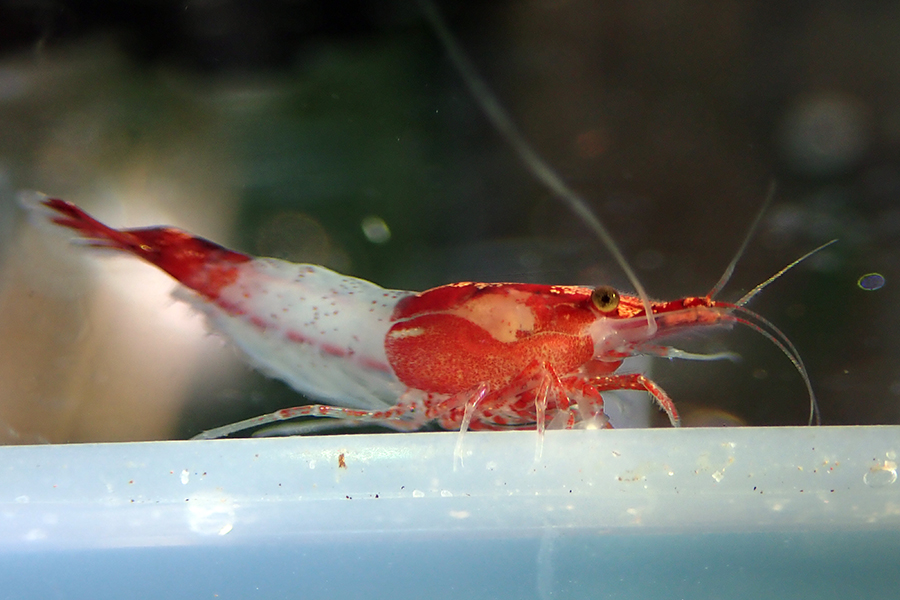
Cherry Shrimp
Scientific Name : Neocaridina davidi
Classification : Animalia (Kingdom) Arthropoda (Phylum) Crustacea (Subphylum) Malacostraca (Class) Decapoda (Order) Caridea (Infraorder) Atyidae (Family) Neocaridina (Genus) Neocaridina davidi (Species)
Source : Popular among the aquarium trade, breeding has spawned various coloured morphs. For the purpose of presenting consistent data from a model breed, samples were collected from adult females of the red banded inbred variant first reported by Kenny et al, 2014, which was initially misidentified as Neocaridina denticulata. Tissue samples for the N. davidi transcriptome include; eyestalk, gills, ovaries, hepatopancreas, and muscle. Transcriptomes were also sequenced for early development and late development (eyespot) eggs, newborn larvae as well as juveniles (<2 week).
Scientific Name : Neocaridina davidi
Classification : Animalia (Kingdom) Arthropoda (Phylum) Crustacea (Subphylum) Malacostraca (Class) Decapoda (Order) Caridea (Infraorder) Atyidae (Family) Neocaridina (Genus) Neocaridina davidi (Species)
Source : Popular among the aquarium trade, breeding has spawned various coloured morphs. For the purpose of presenting consistent data from a model breed, samples were collected from adult females of the red banded inbred variant first reported by Kenny et al, 2014, which was initially misidentified as Neocaridina denticulata. Tissue samples for the N. davidi transcriptome include; eyestalk, gills, ovaries, hepatopancreas, and muscle. Transcriptomes were also sequenced for early development and late development (eyespot) eggs, newborn larvae as well as juveniles (<2 week).
Description : N. davidi is a freshwater shrimp originating from Taiwan. Mating follows shortly after ecdysis and fertilised eggs are attached to pleopods. Approximately 20-30 eggs are laid where they hatch around 30 days. Larvae moult frequently in the first days and morph into post-larvae juvenile shrimp. Males tend to be smaller than females with narrow abdomens, mature females have longer abdominal skirts adapted to protecting fertilized eggs. Shrimp grow to 1-2cm in length with a lifespan of 1-2 years, and reach sexual maturity by 4-6 weeks from hatching.
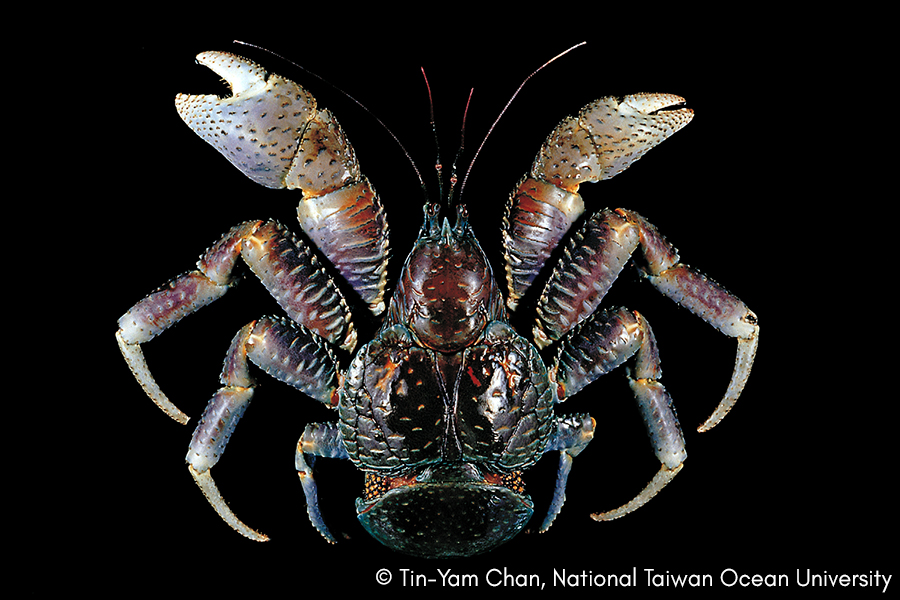
Coconut Crab
Scientific Name : Birgus latro
Classification : Animalia (Kingdom) Arthropoda (Phylum) Crustacea (Subphylum) Malacostraca (Class) Decapoda (Order) Anomura (Infraorder) Ceonobitidae (Family) Birgus (Genus) Birgus latro (Species)
Source : Considered a delicacy in some Asian market, adult crabs were sourced from local markets of Okinawa, Japan, which were imported from various Pacific island locales. Tissue samples for the transcriptomes include; eyestalk, gills, hepatopancreas, and muscle.
Scientific Name : Birgus latro
Classification : Animalia (Kingdom) Arthropoda (Phylum) Crustacea (Subphylum) Malacostraca (Class) Decapoda (Order) Anomura (Infraorder) Ceonobitidae (Family) Birgus (Genus) Birgus latro (Species)
Source : Considered a delicacy in some Asian market, adult crabs were sourced from local markets of Okinawa, Japan, which were imported from various Pacific island locales. Tissue samples for the transcriptomes include; eyestalk, gills, hepatopancreas, and muscle.
Description : latro is the largest terrestrial invertebrate and its natural distribution across the tropical islands of the Indian and Pacific Oceans is facilitated by the migration of long planktonic larvae stages. Mating occurs frequently during mating season between June to September. Females extrude and carry eggs under their abdomen for several months. Larval hatching takes place on rocky shores during high tide. Planktonic larvae progress through five Zoeal stages before settlement into the glaucothoe stage with the adoption of protective a gastropod shell and migration to shore as other hermit crabs. Coconut crabs grow to 40 cm in body length, weighing up to 4kg and take around 5 years to reach sexual maturity. Adults are uniquely adapted to their terrestrial habitat with a hardened terga and soft lower abdomen tucked in, allowing them to shed their shell. Respiratory adaptation to their terrestrial environment is facilitated by their branchiostegal lungs.

Coral Shrimp
Scientific Name : Stenopus hispidus
Classification : Animalia (Kingdom) Arthropoda (Phylum) Crustacea (Subphylum) Malacostraca (Class) Decapoda (Order) Stenopodidea (Infraorder) Stenopodidae (Family) Stenopus (Genus) Stenopus hispidus (Species)
Source : Popular among marine aquariums, adult females were sourced from the local aquarium trade of Hong Kong which were collected from tropical reefs around the Pacific seas. The long planktonic larval stages support the wide dispersal of S. hispidus across the Indo-Pacific region with a study supporting the diversion of Western Atlantic and Indo-Pacific lineages. Tissue samples for the transcriptomes include; eyestalk, gills, ovaries, hepatopancreas, and muscle. Transcriptomes were also sequenced for early development and late development (eyespot) eggs, as well as newborn larvae. 16S and COI gene sequences were used to confirm the species identity of animal samples.
Scientific Name : Stenopus hispidus
Classification : Animalia (Kingdom) Arthropoda (Phylum) Crustacea (Subphylum) Malacostraca (Class) Decapoda (Order) Stenopodidea (Infraorder) Stenopodidae (Family) Stenopus (Genus) Stenopus hispidus (Species)
Source : Popular among marine aquariums, adult females were sourced from the local aquarium trade of Hong Kong which were collected from tropical reefs around the Pacific seas. The long planktonic larval stages support the wide dispersal of S. hispidus across the Indo-Pacific region with a study supporting the diversion of Western Atlantic and Indo-Pacific lineages. Tissue samples for the transcriptomes include; eyestalk, gills, ovaries, hepatopancreas, and muscle. Transcriptomes were also sequenced for early development and late development (eyespot) eggs, as well as newborn larvae. 16S and COI gene sequences were used to confirm the species identity of animal samples.
Description : S. hispidus distribution is pantropical. It is found in habitats below the intertidal zones, especially in coral reefs where it is known to be among the group of cleaner shrimps that form beneficial relationships with fish by removing parasites and dead tissue from their client fish. They are territorial and form monogamous relationships. They have been described as highly social animals with ritual displays before their various interactions in attracting a mate as well as advertising their cleaning stations to client fish, and can recognize individuals, demonstrated through mate recognition among conspecifics. Mating occurs shortly after females moult. Females extrude and carry eggs under their abdomen for 2-3 weeks. Planktonic larvae progress through nine larval stages over a period of 120-210 days before settlement. Females are thought to reach sexual maturity at 30mm total length. Adults have been reared in aquariums for up to 2-3 years.
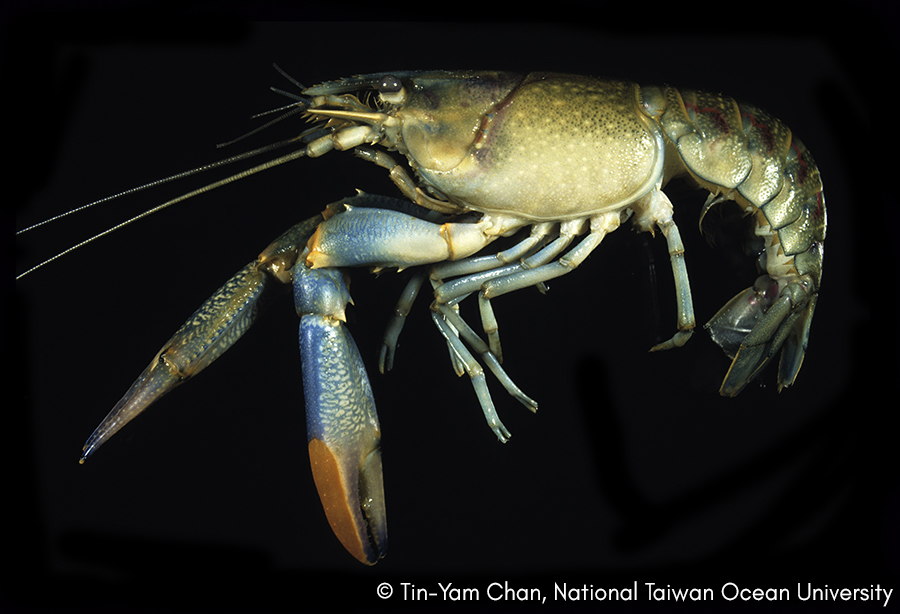
Redclaw Crayfish
Scientific Name : Cherax quadricarinatus
Classification : Animalia (Kingdom) Arthropoda (Phylum) Crustacea (Subphylum) Malacostraca (Class) Decapoda (Order) Astacidea (Infraorder) Parastacidae (Family) Cherax (Genus) Cherax quadricarinatus (Species)
Source : Commercial farming has spread to many parts for the world with the temperate climate requirements for this freshwater crayfish. Adult females and life stages were sourced from a local crayfish farm in Queensland, Australia. Tissue samples for the transcriptomes include; eyestalk, gills, ovaries, hepatopancreas, and muscle. Transcriptomes were also sequenced for early development and late development (eyespot) eggs, newborn larvae, as well as tissues from juvenile crayfish (eyestalk, gills, hepatopancreas, and muscle).
Scientific Name : Cherax quadricarinatus
Classification : Animalia (Kingdom) Arthropoda (Phylum) Crustacea (Subphylum) Malacostraca (Class) Decapoda (Order) Astacidea (Infraorder) Parastacidae (Family) Cherax (Genus) Cherax quadricarinatus (Species)
Source : Commercial farming has spread to many parts for the world with the temperate climate requirements for this freshwater crayfish. Adult females and life stages were sourced from a local crayfish farm in Queensland, Australia. Tissue samples for the transcriptomes include; eyestalk, gills, ovaries, hepatopancreas, and muscle. Transcriptomes were also sequenced for early development and late development (eyespot) eggs, newborn larvae, as well as tissues from juvenile crayfish (eyestalk, gills, hepatopancreas, and muscle).
Description : C. quadricarinatus is found naturally in the fresh water streams and lakes of Northern Australia, and in parts of New Guinea and Indonesia. Mating occurs shortly after females moult. Females spawn 300-800 eggs and carry them under their abdomen for about six to ten weeks. Hatchlings resemble the adult form and remain attached to the underside of the female for several weeks. Sexual maturity is reached at 6-12 months with a body weight of approximately 110-120 g. Life span is 4-5 years with maximum size recorded up to 650 g. of particular note is that a small number of intersex individuals can be found among the populations of C. quadricarinatus, where investigations demonstrate the role of the androgenic gland in sex determination sexual plasticity.
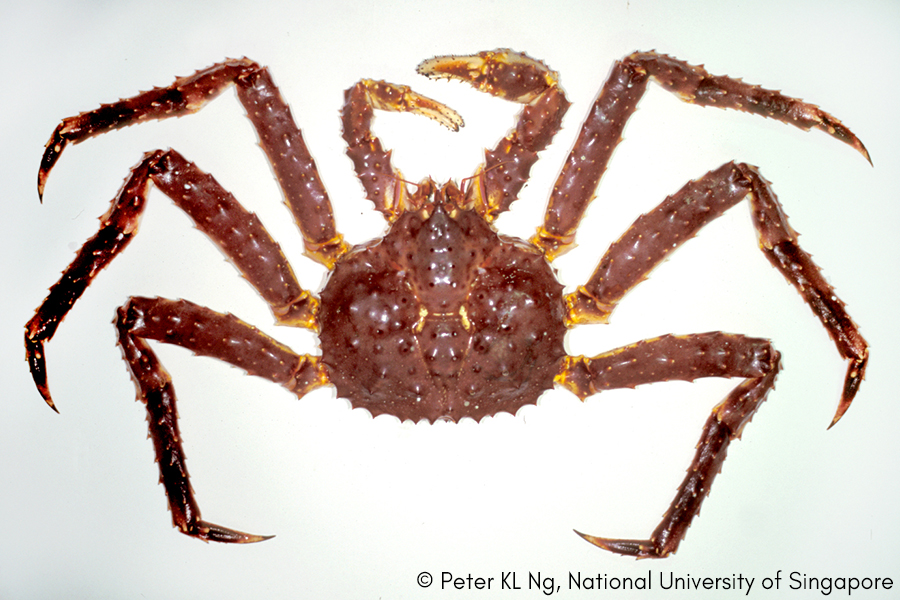
Red King Crab
Scientific Name : Paralithodes camtschaticus
Classification : Animalia (Kingdom) Arthropoda (Phylum) Crustacea (Subphylum) Malacostraca (Class) Decapoda (Order) Anomura (Infraorder) Lithodidae (Family) Paralithodes (Genus) Paralithodes camtschaticus (Species)
Source : Sustainable commercial fishing only allows the capture of male stock for consumption. Adult males were sourced from local distributors importing from the Alaskan sea catches. As the blue king crab (Paralithodes platypus) inhabit similar regions and grow to similar size with some colour morphs resembling P. camtschaticus, the 16S and COI gene sequences were used to confirm the species identity of animal samples. Tissue samples for the transcriptomes include; eyestalk, gills, hepatopancreas, and muscle.
Scientific Name : Paralithodes camtschaticus
Classification : Animalia (Kingdom) Arthropoda (Phylum) Crustacea (Subphylum) Malacostraca (Class) Decapoda (Order) Anomura (Infraorder) Lithodidae (Family) Paralithodes (Genus) Paralithodes camtschaticus (Species)
Source : Sustainable commercial fishing only allows the capture of male stock for consumption. Adult males were sourced from local distributors importing from the Alaskan sea catches. As the blue king crab (Paralithodes platypus) inhabit similar regions and grow to similar size with some colour morphs resembling P. camtschaticus, the 16S and COI gene sequences were used to confirm the species identity of animal samples. Tissue samples for the transcriptomes include; eyestalk, gills, hepatopancreas, and muscle.
Description : P. camtschaticus is native to the Bering Sea, around the Kamchatka Peninsula and neighboring Alaskan waters, and was also introduced to the Barents Sea during the 1960s to provide another source of catch in Europe. Adult king crabs usually inhabit deeper cold waters (200 m deep) and migrate to shallower depths during mating season. Females produce 50,000-500,000 eggs which they carry in their abdominal flaps for 11-12 months. Planktonic larvae progress through several moults over a period of 2-3 months before metamorphosis into glaucothoe. Juveniles inhabit shallow waters before migrating to greater depths as they grow. Crabs are thought to reach sexual maturity after 7 years with a lifespan of up to 20-30 years.
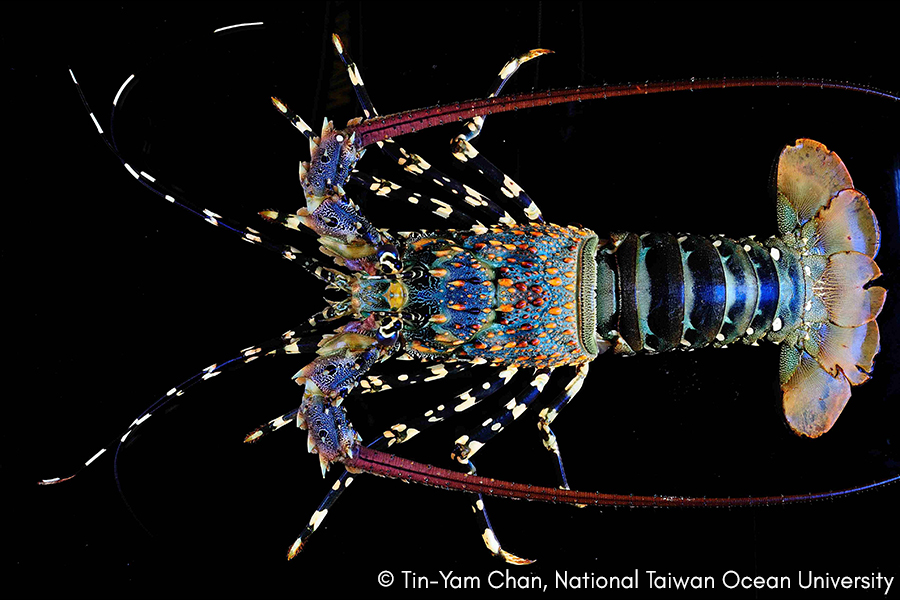
Spiny Lobster
Scientific Name : Panulirus ornatus
Classification : Animalia (Kingdom) Arthropoda (Phylum) Crustacea (Subphylum) Malacostraca (Class) Decapoda (Order) Achelata (Infraorder) Palinuridae (Family) Panulirus (Genus) Panulirus ornatus (Species)
Source : Spiny lobsters are prized for their size and meat, and wild catches are a staple around seafood markets. Adult females were purchased from local markets in Hong Kong. Panulirus homarus is also popular for the same attributes, and as some colour pattern morphs are similar to that found in P. ornatus, the 16S and COI gene sequences were used to confirm the species identity of animal samples. Tissue samples for the transcriptomes include; eyestalk, gills, hepatopancreas, ovaries, and muscle.
Scientific Name : Panulirus ornatus
Classification : Animalia (Kingdom) Arthropoda (Phylum) Crustacea (Subphylum) Malacostraca (Class) Decapoda (Order) Achelata (Infraorder) Palinuridae (Family) Panulirus (Genus) Panulirus ornatus (Species)
Source : Spiny lobsters are prized for their size and meat, and wild catches are a staple around seafood markets. Adult females were purchased from local markets in Hong Kong. Panulirus homarus is also popular for the same attributes, and as some colour pattern morphs are similar to that found in P. ornatus, the 16S and COI gene sequences were used to confirm the species identity of animal samples. Tissue samples for the transcriptomes include; eyestalk, gills, hepatopancreas, ovaries, and muscle.
Description : P. ornatus is found in the Indo-West Pacific region. A reef dwelling species, they usually inhabit depths aroun 1-50 m and can be found in groups hidden in coral and coastal rocky reefs and surrounding areas. After mating during the summer season, females store the male spermatophore until she is ready to spawn. Each female may spawn several hundred thousand to over one million eggs. After incubation of 3-4 weeks, females migrate to the edge of the continental shelf to release her larvae at night. Phyllosoma larvae can swim and migrate through the pelagic column, progressing through 11 metamorphic stages involving up to 20 moults, until finally settling into puerulus form. The puerulus has the form of a transparent lobster, and is free swimming. It is a non-feeding form and survives off accumulated energy reserves over 2-3 weeks. As the puerulus finds a suitable reef habitat, it forms pigmentations and moults into juvenile lobsters. Post-puerulus juveniles take around 24 motnhs to mature to adults (~1 kg). Adults have been recorded to survive up to 20 years.
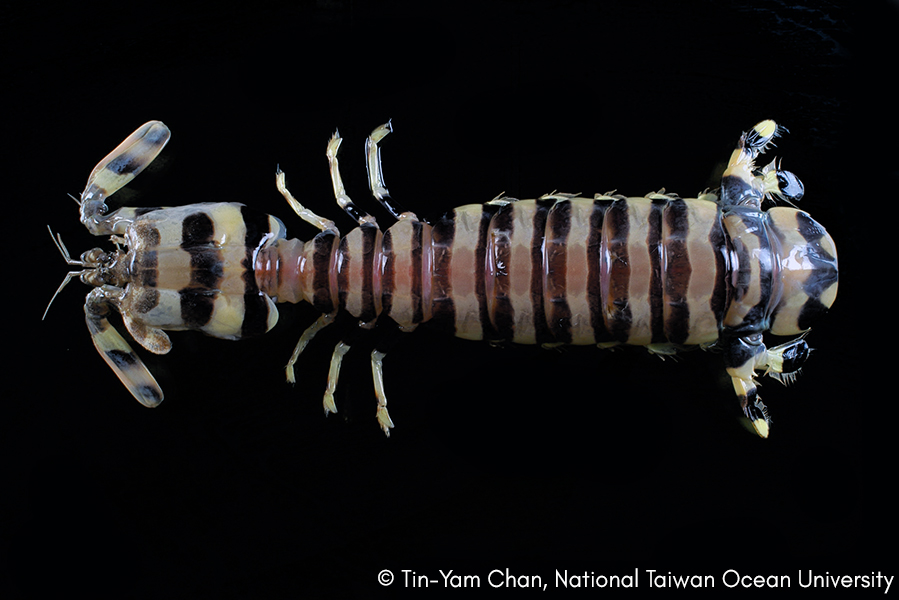
Zebra Mantis Shrimp
Scientific Name : Lysiosquillina maculata
Classification : Animalia (Kingdom) Arthropoda (Phylum) Crustacea (Subphylum) Malacostraca (Class) Stomatopoda (Order) Unipeltata (Suborder) Lysiosquilloidea (Superfamily) Lysiosquillidae (Family) Lysiosquillina (Genus) Lysiosquillina maculata (Species)
Source : Adult females were procured from the local seafood market in Hong Kong. These are likely harvested from nearby shores of the Pacific. Congengic Lysiosquillina sulcata has very similar zebra banding patterns distinguishable from L. maculata by the colouration of the endopod. Regardless, 16S and COI gene sequences were used to confirm the species identity of animal samples. Tissue samples for the transcriptomes include; eyestalk, gills, hepatopancreas, ovaries, and muscle.
Scientific Name : Lysiosquillina maculata
Classification : Animalia (Kingdom) Arthropoda (Phylum) Crustacea (Subphylum) Malacostraca (Class) Stomatopoda (Order) Unipeltata (Suborder) Lysiosquilloidea (Superfamily) Lysiosquillidae (Family) Lysiosquillina (Genus) Lysiosquillina maculata (Species)
Source : Adult females were procured from the local seafood market in Hong Kong. These are likely harvested from nearby shores of the Pacific. Congengic Lysiosquillina sulcata has very similar zebra banding patterns distinguishable from L. maculata by the colouration of the endopod. Regardless, 16S and COI gene sequences were used to confirm the species identity of animal samples. Tissue samples for the transcriptomes include; eyestalk, gills, hepatopancreas, ovaries, and muscle.
Description : The distribution of L. maculata is found across the Indo-pacific from Hawaii to East Africa. They are found in low intertidal areas along sandy reef flats and form ‘U’ shaped burrows, reinforced with mucus bound sand below the intertidal zones. They are known for their remarkable hunting appendages as well as the complexity of their eyesight. Lysiosquillina live in monogamous pairs. During mating, males produce sperm ducts to be delivered to the female pouch for storage rather than spermatophores, and females can brood up to 50,000 eggs. Females migrate out to sea for the eggs to hatch where planktonic Zoea undergo 3 larval stages over 3 months before metamorphosing into benthic juveniles. Juveniles inhabit deeper waters and create deep burrows, growing rapidly as they move closer to the shallow shoreline. The lifespan of L. maculata is typically 3-6 years with records up to 20 years.

